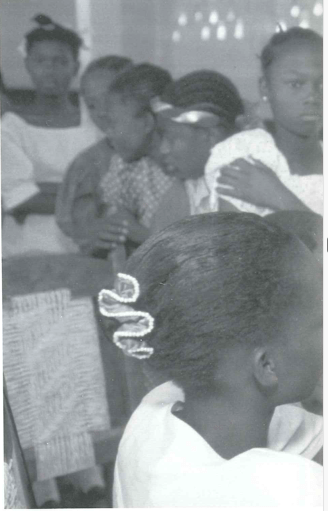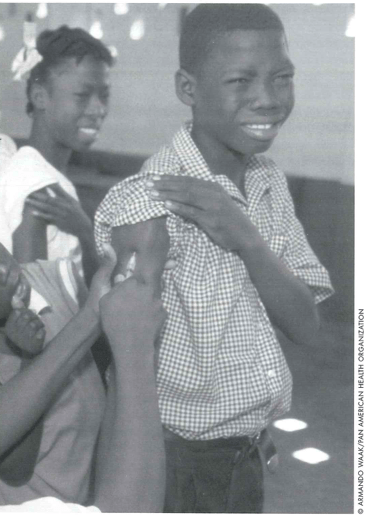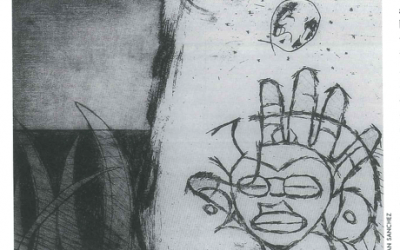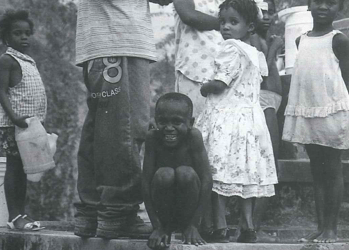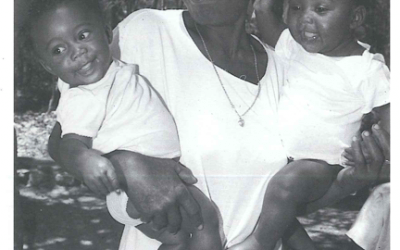Infectious Diseases
Looking at Medicine and Social Justice
- Vaccination and other interventions have lowered infant mortality in Latin America and the Caribbean, but treat- able infections continue to kill the poor.
Harvard Medical School’s pre-clinical curriculum has some telling blind spots. During the first two years, we mostly discussed diseases prevalent in the United States and other developed nations. Many lectures and tutorials were devoted to atherosclerosis and it’s common variants: coronary artery disease, cerebrovascular disease, and peripheral vascular disease. Other, more common diseases among the world’s population were discussed less frequently. Tuberculosis, say, was only given four hours of attention.
When infectious diseases were finally discussed, our instructors peppered their lectures with comments such as, “Don’t worry about this because it is exceedingly rare in the United States,” or, “This is not seen in the U.S.” They failed to mention that many rare diseases in the United States are significant causes of morbidity and mortality around the globe. Infectious diseases remain the world’s single most common cause of death. Recent surveys suggest that some two billion people nearly one-third of the world’s population are infected with the tubercle bacillus. Coronary artery disease kills some 500,000 Americans each year, most of them elderly; although tuberculosis kills few in the United States, each year it claims almost two million lives, making it the leading cause of young adult mortality worldwide. Complications of HIV infection have joined tuberculosis to become the leading cause of young adult death in many parts of the world. Even in the United States, treatable infections continue to kill the poor. In one cohort of New York City welfare recipients, TB and HIV were leading causes of death. It was as if the first two years of medical school were taught with blinders on, keeping diseases that affect the poor and marginalized out of view.
HAITI
During my pre-clinical years, I spent several months at a small hospital in Cange, on Haiti’s Central Plateau. Haiti humbled me, brought tears to my eyes, and lit a fire in my heart.
The clinic, run by Partners In Health and its sister organization, Zanmi Lasante, is located in the destitute Péligre basin of Haiti’s Central Plateau. A 1956 hydroelectric dam flooded out thousands of peasant farmers, most of whom received no compensation for their lost land. Over the past 15 years the Haitian staff of Zanmi Lasante has served these landless peasants and their children.
More than 50,000 patients visit the Clinique Bon Sauveur each year. The main clinic has a staff of 50 including six physicians and a nursing staff and houses 30 hospital beds, four isolation beds, and a couple of post-operative beds. A new referral center for multidrug-resistant tuberculosis contains 20 more beds. Over the years, Zanmi Lasante has become the largest employer in the Central Plateau, creating jobs for the families that had lost their land.
Most peasants lived in poorly constructed shacks, surrounded by even poorer land. I couldn’t believe my eyes when I saw a woman planting seeds in what appeared to be a field of large white rocks. I realized later that there was, in fact, corn growing in the small spaces between the rocks. The hot, arid environment of the deforested Central Plateau acts like a kiln, scorching the earth, making farming virtually impossible. And yet that is precisely what this woman and her neighbors have to do in order to survive.
One afternoon, Dr. Paul Farmer and I stopped to see Adeline, a young woman suffering from advanced HIV disease. Most people in the United States would long since have been receiving treatment with state-of-the-art antiretroviral medications, coupled with antibiotic prophylaxis. But the annual cost of these medications can exceed $14,000, and initially Partners In Health could treat Adeline only for opportunistic infections. These came in rapid succession. In 1999, she was hit hard by a chronic enteropathy (an intestinal disease that causes a wasting diarrhea). Her weight dropped significantly, and by June, when we saw her, she weighed 79 pounds and was too weak to walk.
That November, Adeline began therapy with three potent antiviral drugs to treat her HIV disease. Adeline does not pay for her medicine; it is donated by supporters of Partners In Health. In addition to medication, she receives financial assistance and nutritional supplementation. Although many public-health experts would argue that it is not “cost-effective” to treat Haitian peasants with expensive medications, it seems that “unorthodox” solutions are necessary for a virus that seems to have settled amongst the poor, much like other infectious pathogens.
We also stopped to visit Absoly, a peasant farmer in the same village. Absoly was physically slight; his thin, sinewy build and work-worn hands revealed a lifetime of hunger and hard labor. Fifteen years ago, before the hospital in Cange was constructed, he fell victim to a serious infection in his right leg. The unchecked infection progressed until it damaged the blood supply to his leg. The residual, necrotic tissue created an ideal environment for parasites, and his leg soon became infested with maggots. With the help of his family he was eventually able to reach the nearest hospital, some six hours by foot and even farther on a makeshift stretcher. His right leg was amputated at the hip. After a long recovery he was forced to use his hands to ambulate; his remaining leg became misshapen and atrophied.
When we visited Absoly, he was living in a “house” with his wife and child. I use quotation marks because the dwelling was no larger than seven by five by eight feet there was scarcely enough room for his sleeping mat. The walls and roof provided little protection from the elements. As storm clouds were gathering, I stared at the dirt floor and at the thatched roof, imagining what it would be like to sleep there for even a single night.
Just before our arrival, a Zanmi Lasante community-health worker had met Absoly in the course of regular walks through the catchment area to identify people with acute social, economic, and health problems. The health worker knew that the best health intervention we could make would be to build a house another “unorthodox” medical intervention in the eyes of some. As we spoke to Absoly and his family, less than 40 feet from his shack, construction workers were clearing the ground for a new home, which would be covered by a tin roof and have a cement floor.
Five weeks later I paid my final visit to Kay Epin. Absoly’s new house was almost complete the tin roof was up, the wooden walls were standing tall, and plans were underway to fill in the dirt floor with cement. As we were leaving the construction site, a community-health worker, reflecting on the role of Partners In Health in rural Haiti, commented, “God catches the crabs and places them in the blind man’s sack.”
A year later, Paul Farmer and I were sitting in his office at the clinic when he called for the next patient, who was thought to have infectious pulmonary tuberculosis. Since I hadn’t yet been exposed to tuberculosis, I was asked to leave the room. I passed Dominique in the hallway: a six-foot-tall man who, supported by his mother and sister, lacked the strength to stand. He was covered in a cold sweat, and undoubtedly feverish. His emaciated body gave me an entirely new understanding of the age-old term for tuberculosis: consumption. TB had consumed every aspect of Dominique, and it now threatened to take his life.
It took them nearly four minutes to walk the 20 feet that separated the waiting area from the office. The diagnosis was obvious, even to a second-year medical student. The only question that remained was his survival. The order was given for him to be admitted and to be immediately started on antituberculous drugs.
Farmer told me that Dominique had been sick for several months, and there was talk that he had been to see an herbalist, or doktí fey, before he arrived at the clinic. Dominique’s radiograph bore almost no similarity to normal human anatomy. His right lung had been completely consumed by TB. His heart, and what remained of his left lung, had been pulled to the right side of his chest. After viewing the radiographs, Farmer commented that this was one of the sickest TB patients he had ever encountered, and he was unsure of his prognosis.
Later that evening we went to check on Dominique. I stood at the doorway as Dr. Farmer examined him. I watched him listen to the right side of the chest for heart and lung sounds. He touched Dominique on the arm and tried to reassure him. I, too, believed that although Dominique was very sick, he would eventually live to tell his friends and family about his brush with death.
Unfortunately, I was mistaken. The next evening, as I finished dinner, one of the doctors caring for Dominique delivered the news: Dominique had died suddenly, in the middle of a conversation with his mother. The news hit me very hard, and I initially refused to believe it. Dominique had looked much better earlier that day, and had even gotten out of bed to take a few steps. Another doctor had examined him 30 minutes earlier, and Dominique looked like he was beginning to respond to treatment. Why, then, did Dominique die? The explanation, in fact, was quite clear. A lifetime of poverty, hunger, and finally, tuberculosis, had consumed him.
PRAGMATIC SOLIDARITY
At last year’s Haitian National Tuberculosis Program conference, Farmer and I found out that the Départment du Centre, which includes the Zanmi Lasante catchment area, had the highest cure rate well over 90% of Haiti’s nine “departments.” The Central Plateau cure rates exceed some in the United States, and far surpass most other TB programs in Latin America. Another department, by contrast, had a 26% cure rate. Everyone in the meeting was astounded. “How do you get such high cure rates?” asked the Surgeon General. Farmer explained that, contrary to the belief of some in the room, patients are not inherently non-compliant (non-compliance is often cited as the reason for low cure rates, obscuring other factors that affect efficacy of treatment). Farmer continued, “We have such high cure rates because we remove barriers that prevent patients from complying.” Cure rates in the Central Plateau did not significantly improve until Zanmi Lasante started giving financial and nutritional assistance to their patients. Free care alone was insufficient.
The role of the community-health workers is also crucial to the success of the TB program. The 70 community-health workers are proud of their role in good TB outcomes, and they aim to have zero patients abandon treatment this year. To date, no abandons have been documented.
While in Haiti, I was able to witness the final stages of construction of the new Thomas J. White Center. Imagine, a top-notch infectious disease center in rural Haiti! Surrounded by naysayers, Partners In Health and Zanmi Lasante have built a facility to help people like Adeline and Absoly recover from treatable infections. The Center has been named the national referral center for multidrug-resistant tuberculosis. In-patient capacity has doubled, and the new lab is efficient and reliable. Another radiology suite is under construction, and the new pharmacy is already stocked with medicines to treat TB, HIV, and other infectious diseases.
ASKING HARD QUESTIONS
During the course of my time in Haiti, I began to lose sight of my own needs and desires. I came to realize that the destitute sick deserve preferential treatment. I started to understand that diseases settle in the poor because they have been forced to endure hunger, famine, political violence, and inequality “structural violence.”
When I first arrived in Cange, I was so struck by the abject poverty and suffering that I wrote a lifelong friend an emotional, heartfelt e-mail. His response, which consisted of one line, shocked me: “Sounds pretty depressing. What else is going on down there?” I am not disappointed because I know he and I are drifting apart. Rather, I am disappointed because he embodies the sentiments of the majority of people who have not known hunger, violence, and a near-total lack of heath care. Few stop to think about social and economic inequalities that surround them. The Uruguayan theologian Juan Segundo put it something like this: “The world that is so comfortable for us is the same one that is so unbearable for billions of others.”
While U.S. pet owners spend nearly three billion dollars annually on veterinary care, the International Federation of Red Cross and Red Crescent Societies report that most of last year’s 13 million deaths from infectious disease could have been prevented at a cost of $5 dollars per person. I struggle to understand the apparent indifference of those, like me, who live in comfort. Sometimes I wonder if we see the poor as another species.
The most important and meaningful moments in my life have been in Haiti. I melted when I saw a mother and father smile with joy when their child was cured. I got goose bumps when I saw a patient with typhoid, who was bedridden a few days earlier, up and walking. I feel blessed to be able to work for Partners In Health and to have become involved in such important work. As Dr. Jim Kim, the director of Partners In Health, often says, there is not a long line of people waiting to fight for the social and economic rights of the poor. I have already signed up for this battle, and I am working my way towards the front of the line.
Fall 2000
David Walton is a third-year medical student at Harvard Medical School and a volunteer at Partners In Health. In conjunction with Harvard’s Program in Infectious Disease and Social Change and Dr. Paul Farmer, he has published several papers on tuberculosis, HIV, and social and economic rights. He plans a career in infectious disease.
Related Articles
Latino Mental Health
What brings you in to see me today?” This is the typical question asked of new patients during a psychiatric evaluation in a Boston clinic. When asked of a Latino patient, however, the answer…
Health: the Hope of Haiti
At no time have I felt more vital than in serving at Partners In Health (PIH), and seldom more needed than in places like Haiti. In the Haitian people, as well as in every other country that PIH serves, we find an…
Whither Equity in Health?
A waiting room in a charity clinic in rural Haiti. It is a humid afternoon, and huge drops of warm rain are starting to fall. A young woman is watching as her ten-year-old son, Dominique, clutches…

